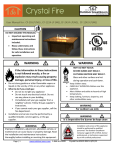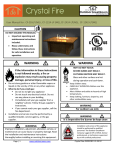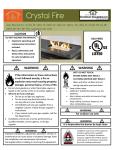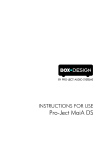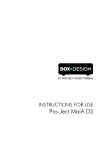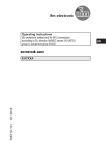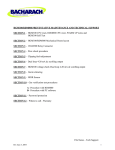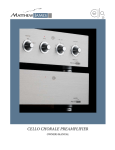Download Troubleshooting Charging System
Transcript
Electrical Troubleshooting Electrical questions seem to come up over and over again, so I want to try to take some of the mystery out of it. I am going to write this for the new guy who doesn't have a lot of experience. I am going to try to keep things as simple and straight forward as possible. You guys with a little more experience, please look past that and chime in if I miss anything, or you know a better way to do it. If you have a question about your system, please post it in another thread and try to keep this more informational. I am going to skip over as much of the theory as possible. No need to confuse things. If I don't have spark, I don't give a shit how my coils turn 12V into 20,000. I just want to know if it works. These parts are modified and replaced regularly, so when I list specs that are specific to the stock CB750, I will put them in RED. Specs for something as a general guideline, a generic number for aftermarket goodies, I will use BLUE. I will try to break each component into it's own little post, and add to it as I have time. You need to get a multimeter. A $5.00 one from harbor freight is much better than nothing. You can only do so much with a test light. Testing coils The coils on these bikes are very easy to test. There are two sides to the coil. The primary and the secondary. The primary side is the small connectors that attach to the wiring harness. The secondary side is the spark plug wire connectors. We are going to test resistance, so the coil must be isolated and de-energized. Basically, disconnect the wires from it. You do not want it attached to the wiring harness for testing. PRIMARY RESISTANCE Set the multimeter to measure ohms. Use one test lead on each of the small terminals that attach to the wiring harness. If using stock coils, you should get a reading of approx 5 ohms. If using DOHC or most aftermarket "hot" coils the reading should be about 3 ohms. If your readings are very far off from the given values, the coil is probably bad. If you do not get a reading, or if it flickers in and out, then there is a broken wire and the coil is bad. SECONDARY RESISTANCE Set the multimeter to measure ohms. Once again we are going to isolate and de-energize the coil. Use one test lead in each of the spark plug wire connectors. You may have to wiggle them around to get them to a spot where you are getting a reading. Depending on the coil you should get a reading of 5Kohms to 20Kohms. I don't have a manual with me so I will edit later for the actual cb750 specs. If you get no reading, the coil is bad. This test can also be performed with the plug wires and caps in place. Due to the extra resistance though you should get a reading between 10Kohm to 50Kohms depending on the coil, wires and caps. If this is done first, and there is no reading, do the test without the wires. If you get a reading with no wires and no reading without, then the wires are most likely your problem. INSULATION BREAKDOWN These coils have a solid metal core running through them. It is used solely for mounting. It is not a ground. Sometimes the insulation inside the coils starts to break down and the coil will short to the metal core. Set the meter to measure ohms, or use the continuity function if your meter has one. You can use resistance(ohms) because even if it has no resistance it will read 0 ohms. This shows that there is continuity. Continuity means that electricity can pass. A wire has continuity, but if you cut it in the middle, it does not. What we are going to do is use one test lead on the center mounting bar. The other test lead is going to go to each of the primary terminals, and each o the secondary terminals. In effect we are doing 4 tests. If any one shows continuity to the center core, then the coil is bad. One other thing to remember is that the coils do get hot with use. It is possible for a coil to test good, but once it gets hot, the insulation inside starts to get gooey and breakdown. If it starts to misfire after it is hot, let it warm up until it happens and check the coil while it is hot. This can be tricky because it still needs to be disconnected first. CHARGING SYSTEM So you think that your bike is not charging correctly. Well let's take a look. The "proper" way to test a charging system is to use a two meter test. Use one meter to check the DC voltage across the battery terminals. For the other, you would use preferably an amp clamp on the + battery cable. This will show you the actual current that is being sent to the battery. There is a table in the service manual to check the actual charging output of the system using these two readings. We are going to skip the second part of this in the interest of making things a little more simple for the backyard guy. This will still give you a good idea if you have a problem or not. Before doing anything electrical, make sure that you have a fully charged battery. A battery that is less than charged is going to throw off the rest of your readings. Start the bike. Set the multimeter to volts DC. Use one lead on each terminal of the battery. According to yuasa a fully charged battery should be reading 12.6Vdc. It is usual for this value to drop when the starter is engaged. The charging system should then start to bring this value up. This value will also increase up to a point depending on the engine's rpm. The following values are from the service manual: RPM Volts dc 1000 12 2000 12.4 3000 13.2 4000 14.5 5000 14.5 6000 14.5 7000 14.5 8000 14.5 If you rev your motor and the battery voltage does not increase then your charging system is not charging. If you rev your motor and the value goes above 14.5 Vdc then it is overcharging. Either way, if something is wrong then we need to start testing components. If the system is overcharging it will usually be due to a bad regulator, so that is the place to start. If it is undercharging or not charging at all then start at the beginning and work back to the battery. This means starting with the stator. TESTING THE STATOR The stator is an AC producing coil. It can and should be tested in three ways. They are resistance, output, and insulation breakdown. RESISTANCE Disconnect the three yellow wires coming from the stator. (If you are still using the stock plug, double check the wiring and terminals. These have been known to get hot then get brittle and the insulation starts to chip leading to a short.) We are going to call these three stator wires s1, s2, and s3. It does not matter which one is which. Set the multimeter to read ohms. Use one end of the meter on s1 and the other on s2. Record your reading. Do the same thing between s1 and s3, and then s2 and s3. You want to get a reading of very close to .2 ohms. Much higher and there is likely a partial break in the wires. The stator is going or is already bad. No reading or an open line between any two leads would indicate a complete break in the wires and the stator is bad. OUTPUT To test the output off the stator, we are going to leave the three yellow wires disconnected. The meter is going to be set to volts AC. Use the red probe of the meter to S1. The black probe of the meter is going to another of the yellow leads, say S2. With the bike running, sheck the AC output. As you rev the motor, the voltage should increase witht he rpms. I don't remember what the number should be at idle, but not very high. It should increase to 50-60 volts AC as the RPMs go up though. Repeat this process for each combination of the the three stator leads. S1-S2, S2-S3, S1-S3. The readings from all three tests should be pretty close to equal. If one leg of the stator is bad, you will have two low readings and can then tell which stator lead is common to the two bad readings. It really doesn't matter though, it is bad and you need to replace the whole thing. Replace the stator. INSULATION BREAKDOWN To check for insulation breakdown, we are going to set the meter to measure ohms. You can use the continuity setting if your meter has it. Use one probe of the meter on one of the three yellow leads from the stator. The other meter probe goes to ground. If the stator is out of the bike, then this lead would go the metal core of the stator. The meter should read OL or open line, or show no continuity depending on the meter. If it does give a reading, then the coil is shorting to ground and the stator is bad. Repeat this for each off the yellow wires. If any one is bad, the entire unit needs to be replaced. TESTING THE FIELD COIL The field coil is the other part along with the stator that makes up the units alternator. I probably should have put this before the stator, because if it is not working properly than the stator will malfunction. If you test the stator first and get bad readings, confirm that the field coil is good before replacing the stator. The field coil is often overlooked, but very easy to test. We are going to test the unit for resistance and insulation breakdown. RESISTANCE Disconnect the leads for the field coil from the regulator. One should be white and the other green. Set the meter to read ohms. Use one probe of the meter on each of the leads. You should get a reading very close to 7.2 ohms. If your reading is very far off then the field coil is bad. If you get no reading, then te unit is also bad. INSULATION BREAKDOWN To test for breakdown we are going to leave the meter set to read ohms. You can use the continuity setting if you have one. Use one probe of the meter to the green lead from the field coil, and the other probe to ground. You should get an open line reading or no continuity. If it shows continuity, then the unit is bad. Repeat this test with the first probe to the white wire. If this test shows continuity to ground, then the unit is bad. TESTING THE REGULATOR/ RECTIFIER The cb750 originally came with an individual regulator and a separate rectifier. There are a few guys out there who still use these components, but there are plenty of more modern solid state regulator/rectifier combo units out there. My personal opinion is that the factory upgraded the system, why shouldn't you? The later DOHC Honda units are a popular upgrade as well as a new aftermarket unit such as the one made by Electrosport and others. I am not going to list wire colors because different manufacturers use different colors. The same tests are going to apply. You need to identify certain wires or terminals from your unit. You can do this by checking the instructions for a new unit, or look at the original wiring diagram for the bike that your unit came from. You need to id the three wires that come from the stator, the ground wire, and the battery charge lead. The stator wires and the ground should be pretty self explanatory, but the battery charge lead (BCL) is the wire that goes from the unit to the battery, (in some cases the solenoid). It is responsible for carrying the current back to the battery to enable it to charge and replace the voltage that is being used by the other systems. DIODES The unit contains a set of 6 diodes. These are what we are going to test first. Diodes are like one way check valves for electricity. It will only allow the current to move in one direction. This is how it transforms ac voltage into dc voltage. The particulars of that do not matter to us though. Set the meter to measure ohms. Place the red lead from the meter on the first stator lead (s1) and the black lead on the BCL. You should get a reading. Record it. Move the red lead to the second stator lead (s2) and keep the black on the bcl. Again , you should get a reading. Do the same with s3. All three of the readings should be very close. The actual value is going to depend on which init you have. Reverse the red and black leads and do the same three tests again. You should get OL or no reading on all three. If you do get a reading then the diode is bad. Therefore the whole unit is bad. To test the ground side diodes, place the red lead on the ground wire and the black on s1, s2, and s3 respectively. You should once again get a reading on all three, and the readings should be close together. Reverse the red and black leads and repeat the test and all three should be OL or have no reading. Again, if you get a resistance, then there is continuity where there should not be and the unit is bad. I usually make a little chart. When complete it should look something like this: Bcl forward Bcl reverse Ground forward Ground reverse S1 X ohms O.L. X ohms O.L. S2 X ohms O.L. X ohms O.L. S3 X ohms O.L. X ohms O.L. OUTPUT The other things that we can check is the output of the unit. We would do this to see if the regulator is kicking in and stopping excess voltage from reaching the battery and overcharging it. This is basically the same as the charging test detailed above. It can also be performed by setting the meter to read Vdc. Put one probe of the meter on the bcl and the other end on a ground. With the motor running, you should see the output of the unit in Vdc. The value should increase with the rpms off the motor and stop at around 14.5V. If it goes much higher then the regulator is not working properly and stopping the excess voltage.





